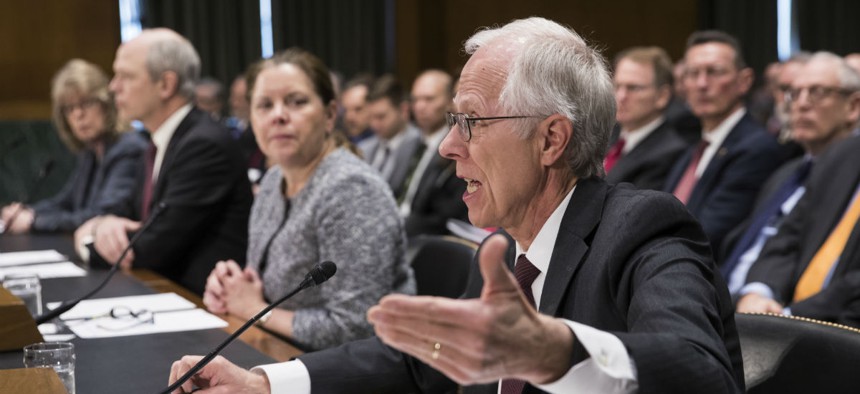
PSC President David Berteau, joined by (right to left) Raytheon VP Jane Chappell, ManTech President and CEO Kevin Phillips, and Brenda Farrell of GAO testify before the Senate Intelligence Committee in March. J.Scott Applewhite/AP
You May Have to Wait 2 Years to Get That Security Clearance
The metrics fail to capture the real-world impact of the backlog, which includes careers put on hold and the loss of top talent, says Raytheon's Jane Chappell.
Security clearance reform is back in the news. Congressional testimony and proposed legislation is drawing attention to the problems with the security clearance process, including a backlog of pending cases which reached 725,000. But there is another number that is much smaller, but much more significant for those awaiting a security clearance determination.
Security clearance processing times for Defense Department contractors have reached a new high—534 days. That means if you apply for a DoD clearance today, you may need to wait more than a year and a half before you receive a final determination. And that’s just the fastest 90 percent of cases. Many applicants report waiting two to three years to receive a security clearance, and their chance at a national security job.
Legislators were quick to point out the problems at a Senate Intelligence Community hearing in March. Pinpointing solutions was more difficult.
“The government’s process for issuing clearances is largely unchanged from when it was established in 1947, and the net result is a growing backlog of investigations, and inefficiencies,” noted Senator Richard Burr, chairman of the Senate Intelligence Committee. He noted the need to consider new technologies, create real-time awareness of employee behavior, and establish efficiencies that will make the process better for the government, contractors, and potential candidates.
“We can all agree, the clearance process should be demanding on candidates . . . but clearly the current system is not optimal, and we must do better,” noted Burr.
Senate hearings come on the heels of the decision by the Government Accountability Office to place the security program back on its high risk list. Security clearance performance relative to timelines has been a recurring issue—73 percent of agencies did not meet timeliness objectives in 2012. Currently, however, meeting the timeliness guidelines seems to be impossible. The GAO noted 98 percent of agencies were unable to meet timeliness objectives in 2016.
“The backlog of 700,000 pending cases is our industry’s number one priority,” said Jane Chappell, vice president of Global Intelligence Solutions at Raytheon. “Given the challenges we face in finding qualified, cleared talent, to meet the mission that we have, we consider it a national security issue, and a government issue. Top professionals are in high demand across the nation. They do not have to wait more than a year to get a job.”
Industry representatives noted how personnel shortages are contributing to national security risks as positions go unfilled and mission performance is compromised.
“Since the end of 2014, we estimate that approximately 10,000 positions required from the contractor community in support of the intelligence community have gone unfilled due to these delays,” testified Kevin Phillips, president and CEO of ManTech International Corporation.
Industry has been warning the government for the past several years that clearance processing delays have real costs, which are reflected in their bottom lines and the pricing they pass along to the government. The cost is both tangible and intangible.
“What the metrics fail to capture is the real-world impact of the backlog . . . the new careers put on hold, top talent lost to non-defense industries and programs that provide critical warfighter capabilities facing delay and cost increases,” said Raytheon’s Chappell. “The delays also come with a real-world price tag.”
The issues with finding and retaining personnel aren’t just due to the issues with attracting entry-level and new talent for government careers. Industry representatives noted reciprocity continues to be one of the largest barriers to effectively putting employees to work, and adds unnecessarily to the clearance backlog.
Government agencies are generally supposed to accept a successfully adjudicated security clearance investigation from another agency. But many continue to require a new investigation, or a separate suitability determination, which often lingers for months just as an investigation does. That means employees are unable to easily move from one government job to another, even within the same agency.
“How can it be that you’re cleared and accepted in one part of the government, and not cleared and accepted in the other parts of the government?’” said David Berteau president and CEO of the Professional Services Council. “There are 23 agencies, but the problem extends beyond that.”
He noted there are 12 different adjudicating offices within the Department of Homeland Security alone. The broken suitability process within DHS was the topic of another congressional hearing, with Berteau testifying to how the lack of security clearance reciprocity is creating redundancy and delays.
“One universally accepted and enforced standard across government is needed,” concurred ManTech’s Phillips.
Industry emphasized they are compliant with new measures taken by federal agencies to help prevent insider threats and ensure a quality cleared workforce. They are also taking their own steps to monitor employee activity on work networks and increase communication between program managers, government representatives, and off-site security and human resources offices. Officials noted the importance of a quality security clearance process, but they questioned if the current procedures were truly contributing to more security, or just lengthier time-to-hire for both private contractors and government agencies.
“Slow security does not constitute good security,” emphasized ManTech’s Phillips.
Lindy Kyzer is the editor of ClearanceJobs.com and a former Defense Department employee.






